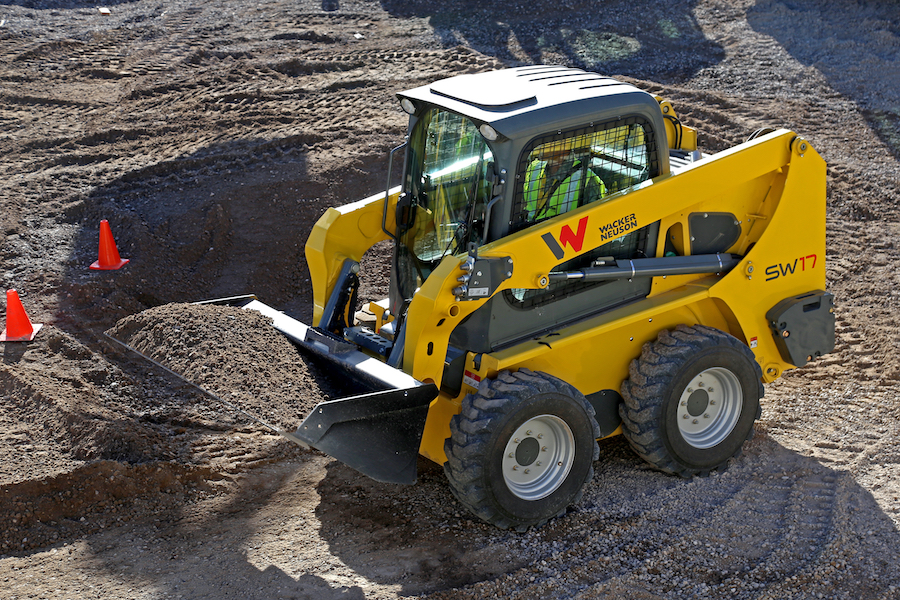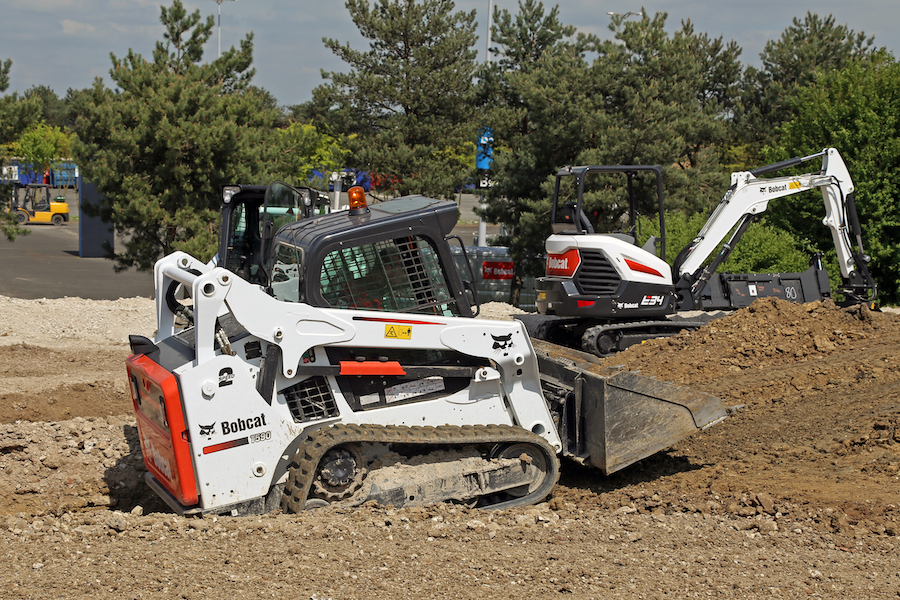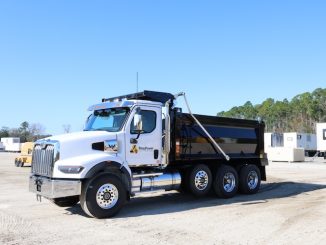View the complete article here.
They say no two things are exactly alike. That applies to skid steers and track loaders. But they are very similar. The differences are in some ways obvious – and in other ways more subtle. In this article we’ll talk about the key differences between skid steers and track loaders and when you should choose one over the other.
Advantages of Skid Steers
Skids Steers Have Wheels
Even the most obtuse among us will note that skid steer loaders have four wheels. Each set of wheels, on the left and right sides, are locked and synchronized mechanically. Each set is independent of the other. The steering is integrated into the system. Meaning you don’t steer – you skid. The wheels literally are dragged across the surface of the ground. This allows zero-radius turning.
Skid Steers Move Faster
Skids steers generally weigh less than track loaders. They can easily be driven on concrete and pavement. The zero-radius turning provides better maneuverability over a track loader.

Skid Steers Press Harder
The wheels on the skid steer exert more pressure into the ground than track loaders. That pressure is evenly distributed between the four wheels. This makes them the preferred option for snow removal and ground compaction. A skid steer’s ability to move faster on hard surfaces make them a good choice for scrap, demolition, and roadwork.
Skid Steers Cost Less
A skid steer, as compared to a similar size track loader, usually costs less to buy. Maintenance tends to be lower too. The key reason skid steers cost less to maintain is that tires wear down at a slower pace compared to tracks. Also, tracks are more expensive to replace than tires. Since skid steers weigh less, it makes them easier and cheaper to transport. It also makes them more fuel efficient.

Advantages of Track Loaders
Track Loaders Don’t Have Wheels
Once again, we state the obvious: track loaders have, well, tracks – not wheels. Tracks provide more traction because they cover a larger area of the ground. This allows you to travel over soft terrain, mud, and snow. (Better to travel over snow, not plow it.)
Track Loaders Are Slow, But Stable
Track loaders move slower than skid steers. But their superior traction makes them more stable. They are a good choice for job sites with slopes or rough terrain. Track loaders are easier on soft ground and delicate areas. Skid steers provide maneuverability but can tear up some surfaces.
Track Loaders Have More Power
Generally, track loaders offer more horsepower and hydraulic flow. They are heavier and can carry greater loads. The weight, however, does not mean more ground pressure. Track loaders won’t compact the soil as much as skid steers do. The pound per square inch (PSI) of ground pressure a skid steer exerts is 30-35. Considerably more than the 4-6 PSI of a track loader.
You Can Lower Maintenance Costs on Track Loaders
You will likely pay more for a track loader, but you can lower maintenance costs by reducing wear and tear on the machine. Unfortunately, many operators drive a track loader like a skid steer. You can extend the life of the tracks and undercarriage by using three-point turns, alternating left and right turns, and changing direction more slowly. Using the right tension on the tracks – not too loose and not too tight – will extend the time between track replacements.
Attachments on Skid Steers and Track Loaders
The most important thing skid steers and track loaders have in common is the attachment mechanism. Modern skids steers and track loaders are equipped with a Universal Quick Attach Plate. Pretty much any attachment will work on both machines.
Attachment Limitations
Just because you can use an attachment on a track loader – doesn’t mean you should. You need to ensure that the machine has enough power to handle the attachment. Turns out the additional hydraulic flow track loaders offer are needed by the tracks and undercarriage. Always talk with your local equipment dealer about the right attachment for the job – and the machine.
Comfort
Track loaders typically have more comfort features – closed cabs, climate control, and cushier seats. But this has more to do with the target audience. Manufacturers tend to offer more comfort options on smaller track loaders often purchased by owner-operators. However, both machines continue to evolve over time. And larger skid steers often have these comfort options available.
Recap of Skid Steers and Track Loaders
Here’s the short list comparison of skid steers and track loaders:
Skid Steers
- Have wheels that generally cost less to replace.
- Initial investment is often less than a comparably-sized track loader.
- Offer more compaction.
- Are more maneuverable but can tear up some surfaces.
- Move faster, especially on hard surfaces.
- Lighter weight can reduce the cost of fuel and transport.
Track Loaders
- Have tracks that are gentler on soft surfaces.
- Are slower but more stable.
- Initial investment and maintenance are more expensive.
- Maintenance costs can be lowered by proper operation and track tension.
- Are heavier but can often handle heavier loads.
- Work well on slopes and rough terrain.
Conclusion
Some of the differences between skid steers and track loaders are obvious – one has wheels, the other tracks. Other differences are purely related to cost. Although both can use any attachments, be careful which attachments you use on a track loader. Ultimately, the specific type of work and job site conditions will help you decide whether you should select a skid steer or a track loader.
View the complete article here.
What are the advantages of skid steers over track loaders, and in which scenarios are skid steers preferred?
Skid steers are preferred for their faster speed, ability to press harder on the ground, lower cost, and suitability for tasks like snow removal, ground compaction, scrap, demolition, and roadwork.
What advantages do track loaders offer, and how do they differ from skid steers in terms of traction, stability, power, and maintenance?
Track loaders provide superior traction over soft terrain, stability on slopes or rough terrain, more power, and potentially lower maintenance costs by reducing wear and tear, making them suitable for heavy loads













































